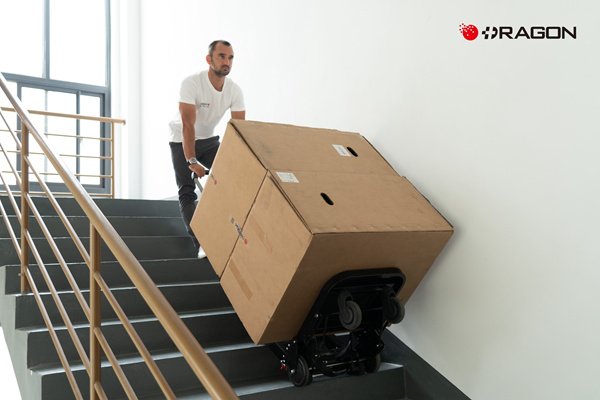Stair Climbing Dolly: Efficiently Move Safes
How to Efficiently Move Safes Up and Down Stairs? The Electric Stair Climbing Dolly Offers a Solution.
For special items like safes, which are expensive and heavy, an efficient solution is required. The particularity of safes is not only reflected in their value, but also stems from their diverse types and structures. Coupled with the different lock designs of electronic locks and mechanical locks, as well as their own heavy raw materials, all make the handling process full of challenges.
Electric Stair Climbing Dolly
In traditional handling methods, manually carrying safes up and down stairs is not only inefficient but also highly prone to damaging the items or causing injuries due to physical exhaustion. However, electric stair climbing dollies, driven by motors with a crawler-type walking structure, can stably carry weights of several hundred kilograms. They precisely control the speed and angle when moving up and down stairs, significantly reducing labor costs and safety risks.
Adaptability
Adaptability is particularly crucial for electric stair climbing dollies when dealing with different types of safes.
Anti-theft safes are usually made of thick steel plates, with their weight concentrated at the bottom of the box.
Fireproof safes, due to the fire-resistant materials filled inside, have an overall higher center of gravity.
Anti-magnetic safes, on the other hand, have a higher density because their shells are made of alloy materials.
Electric stair climbing dollies can adjust the contact area according to the bottom size of the safe, ensuring stability even at an inclined angle.
Fixing and Protection
When moving a safe with an electric stair climbing dolly, the way the safety straps are fastened directly affects the safety of the handling process.
For rectangular anti-theft safes, a crisscross fastening method should be adopted: pass the safety straps through both sides of the safe and tighten them at the fixed points of the stair climbing dolly to ensure the safe fits tightly against the equipment without any gaps.
For small cylindrical fireproof safes, arc-shaped fixing straps must be used to prevent rolling or shifting when going up or down stairs.
For mechanical-lock safes with protruding locks, a soft buffer pad should be placed over the lock area to avoid damage caused by extrusion when the safety straps are tightened.
Customized Solutions
Safes of different specifications require exclusive accessories to optimize the handling process, which is also key to reducing costs and improving efficiency.
In terms of material selection, the durability and adaptability of accessories are equally important. Aluminum accessories are lightweight and corrosion-resistant, making them suitable for use with electronic-lock safes, as they avoid interference with electronic components caused by metal contact. Stainless steel accessories, with high strength and strong load-bearing capacity, are mostly used for fixing mechanical-lock safes and can withstand long-term high-intensity use. Alloy accessories, which combine light weight and high strength, are an ideal choice for anti-magnetic safes, as they do not affect their anti-magnetic performance.
In the production of accessories, DRAGON carries out targeted designs according to the specific parameters of the safe, ensuring that each accessory can be accurately adapted, reducing the difficulty of handling while minimizing wear on the box.
Emergency precautions
It is indispensable to formulate emergency plans. If the box is found to be loose when going up or down stairs, the handling must be stopped immediately, the safety belt must be re-fixed, and the connection of accessories must be checked.
Electric stair climbing dollies provide basic power and load-bearing guarantees, standardized operating procedures ensure safety factors, and customized accessories further enhance adaptability and efficiency, making it easy to cope with the challenges of stair handling.
No. Stair climbing trolleys are typically made of a soft, non-slip rubber base that cushions the pressure of contact with the stairs. Their track structure distributes the weight, reducing pressure on the stairs.
If the damage is caused by a defect in the trolley itself (such as a component failure), the trolley will be repaired or replaced free of charge within the warranty period.
If the damage is caused by improper handling (such as overloading or improperly securing the safe), defects in the safe’s material, or exceeding the product’s rated load capacity, the warranty does not cover it.
No, but it is recommended that you operate the stair climbing trolley correctly according to the instructions.